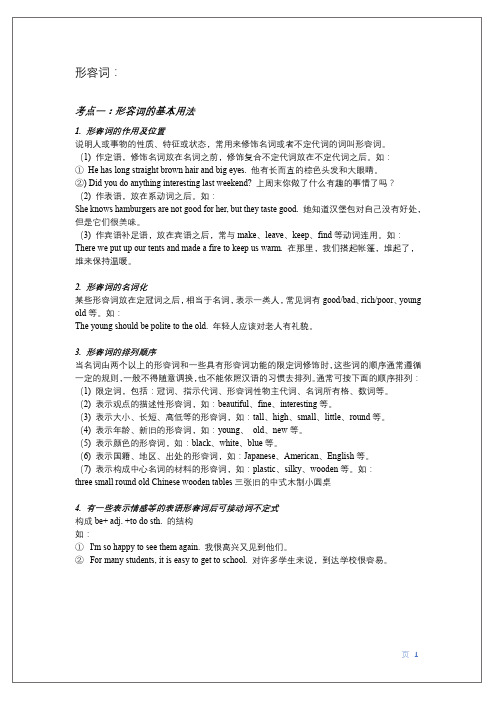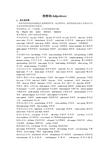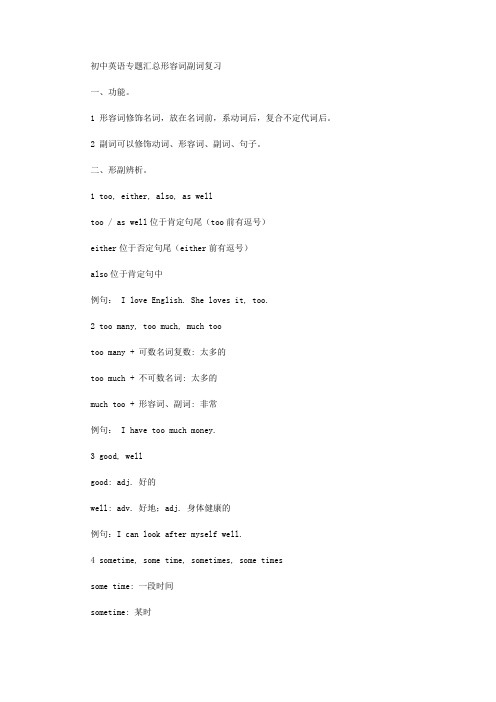初中英语语法总结--形容词
初中英语语法——形容词、副词

初中英语语法——形容词、副词各位读友大家好,此文档由网络收集而来,欢迎您下载,谢谢一、形容词:用来说明或修饰名词、代词的词称为形容词。
1、形容词的句法作用:作句子中名词的定语、句子的表语以及宾语补足语。
2、形容词在句子中的位置:1)、在句子中的位置以及作用⑴作定语时放在名词的前面,且音节少的词放在音节多的词之前。
如:a big yellow wooden wheel⑵作表语时放在连系动词之后。
如:The price sounds reasonable.⑶作宾语补足语时放在宾语之后。
如:We must try our best to keep our environment clean.⑷后置的情况:①修饰复合不定代词时放在代词之后。
如:Something serious has happened tohim.②与表示“长、宽、高、重、老、远离”的词连用时形容词后置。
如:He’s metres moon is about 380,000 kilometres away from the earth.2) 、多个形容词修饰同一个名词的顺序:代词数词性状形容词冠词前的形容词冠词指示代词不定代词代词所有格序数词基数词性质状态大小长短形状新旧温度颜色国籍产地材料质地名词all both such theathis another your second next one four good poorlargeshortsquarenewcoolblackyellowChineseLondonsilkstone二、副词1、副词:用来说明事情发生的时间、地点、原因、方式等含义或说明其它形容词或副词程度的词叫做副词。
2、副词的分类:1时间副词soon, now, early, finally, once, recently2地点副词here, nearby, outside, upwards, above3方式副词hard, well, fast, slowly, excitedly, really4程度副词almost, nearly, very, fairly, quite, rather5频度副词always, often, frequently, seldom, never6疑问副词how, where, when, why7连接副词how, when, where, why, whether, however, meanwhile8关系副词when, where, why3、副词在句子中的位置以及作用:作状语1.时间副词:一般放在句首或句尾,注意,early、late、before、later、yet等一般放在句尾,already、just一般放在动词的前面。
初中英语语法---形容词

形容词:考点一:形容词的基本用法1. 形容词的作用及位置说明人或事物的性质、特征或状态,常用来修饰名词或者不定代词的词叫形容词。
(1) 作定语,修饰名词放在名词之前,修饰复合不定代词放在不定代词之后。
如:①He has long straight brown hair and big eyes. 他有长而直的棕色头发和大眼睛。
②) Did you do anything interesting last weekend? 上周末你做了什么有趣的事情了吗?(2) 作表语,放在系动词之后。
如:She knows hamburgers are not good for her, but they taste good. 她知道汉堡包对自己没有好处,但是它们很美味。
(3) 作宾语补足语,放在宾语之后,常与make、leave、keep、find等动词连用。
如:There we put up our tents and made a fire to keep us warm. 在那里,我们搭起帐篷,堆起了,堆来保持温暖。
2. 形容词的名词化某些形容词放在定冠词之后,相当于名词,表示一类人,常见词有good/bad、rich/poor、young old等。
如:The young should be polite to the old. 年轻人应该对老人有礼貌。
3. 形容词的排列顺序当名词由两个以上的形容词和一些具有形容词功能的限定词修饰时,这些词的顺序通常遵循一定的规则,一般不得随意调换,也不能依照汉语的习惯去排列。
通常可按下面的顺序排列:(1) 限定词,包括:冠词、指示代词、形容词性物主代词、名词所有格、数词等。
(2) 表示观点的描述性形容词,如:beautiful、fine、interesting等。
(3) 表示大小、长短、高低等的形容词,如:tall、high、small、little、round等。
初中英语语法--形容词和副词

形容词(Adjectives)I.定义及分类形容词是用来说明或描述人或事物的性质、状态等的词。
就其构成形式而言,形容词可以分为单词形容词和复合形容词。
单词形容词:由一个词构成,可以带前缀或者后缀。
big diligent pale square dishonest impatient复合形容词:由两个或更多的词构成。
名词+形容词:sea-sick 晕船的air-sick 晕飞机的ice-cold 冰冷的duty-free 免税的snow-white 雪白的blood-thirsty 残忍的world-wide 世界性的shake-proof 防震的water-tight 不漏水的knee-deep 及膝的toll-free 免利息的top-heavy 头重脚轻的名词+名词-ed:iron-willed 意志坚强的ox-eyed 大眼睛的honey-mouthed 甜言蜜语的apple-shaped 苹果形状的lion-hearted 勇敢的silver-haired 银发的hook-nosed 勾鼻子的名词+现在分词:law-abiding 守法的time-consuming 耗费时间的self-sacrificing 自我牺牲的peace-loving 爱好和平的face-saving 顾面子的English-speaking 讲英语的pleasure-seeking 寻欢作乐的heart-rending 令人心碎的soul-stirring 感人肺腑的epoch-making 划时代的man-eating 吃人的fault-finding 喜欢挑剔的labor-saving 节省劳力的mouth-watering 令人垂涎的名词+过去分词:weather-beaten 饱经风霜的heart-felt 衷心的heart-broken 伤心的hand-made 手工的home-made 本国造的state-owned 国有的sugar-coated 糖衣的tongue-tied 结结巴巴的形容词(数词)+名词:long-distance 长途的fine-manner 举止优雅的present-day 当前的five-year 五年的bare-foot 赤脚的first-rate 一流的second-rate 二流的first-class 头等的deep-sea 深海的half-price 半价的one-way 单向(通行)的part-time 兼职的形容词(数词)+名词-ed:white-haired 白发的round-faced 圆脸的double-faced 两面派的teen-aged 十几岁的good-mannered 有礼貌的bad-tempered 坏脾气的narrow-minded 心胸狭窄的noble-minded 品格高尚的kind-hearted 心地善良的absent-minded 心不在焉的smooth-tongued 花言巧语的short-sighted目光短浅的near-sighted 近视的simple-minded 头脑简单的tight-fisted 吝啬的far-sighted 眼光远大的warm-hearted 热心的形容词+现在分词:good-looking 好看的sweet-smelling 好闻的easy-going 随和的thorough-going 彻底的fine-sounding 好听的形容词+过去分词:high-born 出身高贵的ready-made 现成的ready-cooked 烧好的native-born 本地生的new-built 重建的副词+形容词:ever-green 常青的all-round 全能的,全面的over-busy 太忙的over-credulous 过于轻信的over-critical 过于挑剔的(=hypercritical)副词+名词:off-hour 休息时间的off-guard 失去警惕的off-campus 校园外的off-key 不协调的off-budget 预算外的on-line 在线的副词+现在分词:ever-lasting 持久的on-coming 迎面而来的up-coming 即将来临的well-meaning 善意的far-reaching 深远的ever-increasing 不断增加的never-ending 不断的high-ranking 高级的副词+过去分词:well-known 著名的ill-mannered 举止粗鲁的well-behaved 表现好的well-informed 消息灵通的well-balanced 平衡的well-dressed 穿着时髦的badly-wounded 重伤的wide-spread 广泛流传的newly-built 新建的widely-used 广泛使用的well-equipped 装备精良的newly-married 新婚的形容词+形容词:red-hot 炽热的dark-green 深绿的bloody-red 血红的过去分词+介词:unthought-of 没有想到的unpaid-for 没付款的undreamed-of 连做梦也没想到的longed-for 渴望的uncalled-for 未被请求的unlooked-for 非期待的most-talked-about 谈得最多的yet-unheard-of 尚未听说过的(unheard-of=unprecedented)动词(过去分词)+副词:carry-on 随身携带的built-in 嵌入的cast-off 丢弃的drive-in 开车进去的unlived-in 没人住的其他类型:heart-to-heart 推心置腹的well-to-do 富裕的well-off 富裕的down-to-earth 讲究实际的life-and-death 生死攸关的根据其句法功能可以分为定语形容词,表语形容词和通用形容词:定语形容词:1. 起强调作用或特指作用的形容词: actual age chief cause main idea mere child only reason principal food sheer nonsense sole purpose total number2. 由名词转化而来的形容词:atomic energy, criminal law golden opportunity medical college表语形容词:1. 某些以a-开头的形容词: afraid alert alike alive alone aloof ashamed asleep astir awake aware2. 表示健康状况的形容词: faint ill well unwell注:ill作定语时,意为“坏的,邪恶的,恶劣的”如:ill luck/name/news/temper/wound等。
初中英语语法形容词副词讲解

初中英语专题汇总形容词副词复习一、功能。
1 形容词修饰名词,放在名词前,系动词后,复合不定代词后。
2 副词可以修饰动词、形容词、副词、句子。
二、形副辨析。
1 too, either, also, as welltoo / as well位于肯定句尾(too前有逗号)either位于否定句尾(either前有逗号)also位于肯定句中例句: I love English. She loves it, too.2 too many, too much, much tootoo many + 可数名词复数: 太多的too much + 不可数名词: 太多的much too + 形容词、副词: 非常例句: I have too much money.3 good, wellgood: adj. 好的well: adv. 好地;adj. 身体健康的例句:I can look after myself well.4 sometime, some time, sometimes, some timessome time: 一段时间sometime: 某时some times: 几次sometimes: 有时候例句:Sometime you can realize your dream.5 alone, lonelyalone: adj. 独自的;adv. 独自地lonely: adj. 孤独的6 ill, sickill: 当做“生病的”讲时,只用于系动词后sick: 用于名词前或系动词后7 hard, hardlyhard: adv. 努力地;adj. 困难的,坚硬的hardly: adv. 几乎不8 -ed, -ing-ed: 感到...的-ing: 令人...的9 enoughenough用于名词前或形容词副词后三、比较级最高级。
1 比较级最高级构成规则变化。
初中英语语法:形容词考点分析归纳

初中英语语法:形容词考点分析归纳一、多个形容词修饰名词时的排列顺序当多个形容词共同修饰一个名词,它们通常按以下方式排列:描绘形容词—大小(长短高低)形容词—形状形容词—年龄(新旧)形容词—颜色形容词—国籍形容词—材料形容词—用途(类别)形容词—名词。
如:This is a nice(好看的) small(小小的) round(圆形的) new(新的) brown(褐色的) French (法国产的) oak(橡木做的) writing desk(写字台).但是,以上情况并不绝对,例外的情况是常有的,况且以上规则也不好记。
下面再介绍几条原则性的东西,供参考:(1) 总体描述在前,具体描述在后;(2) 主观描述在前,客观描述在后;(3) 普遍性描述在前,特殊性描述在后;(4) 短词在前,长词在后;(5) 与所修饰的名词关系不紧密的在前,关系紧密的在后。
二、表语形容词与定语形容词用法简述1. 表语的形容词所谓表语形容词指的就是只用于连系动词后作表语,不能用于名词前作定语的形容词。
这类形容词主要包括某些以a-开头的形容词,如afraid(害怕的),alike(相同的),alive(活着的),alone(单独的),ashamed(羞愧的),asleep(睡着的),awake(醒着的),aware(意识到的)等。
如:He was half asleep. 他半睡着。
You are lucky to be alive. 你活着算是幸运的了。
The twins look very much alike. 这对双胞胎看上去非常相像。
其他的表语形容词还有(主要限于括号内的意思):fine(健康的),ill(有病的),poorly(健康欠佳的),well(身体健康的),glad(高兴的),pleased(高兴的),sorry(难过的),upset(心烦意乱的),content(满意的),certain (确信的),sure(确信的),fond(喜欢的),ready(准备好的)等。
初中英语语法剖析-形容词

初中英语语法剖析—形容词目录一、形容词的定义 (1)二、形容词的分类 (1)三、形容词的的作用 (1)三、形容词的的位置 (2)四、形容词的的构词 (4)五、形容词的比较等级 (5)六、形容词原级、比较级、最高级的用法 (7)七、常见的比较等级之间的转换 (9)八、常见形容词用法辨析 (10)初中英语语法—形容词一、形容词的定义用来修饰名词或者部分代词的词。
形容词一般翻译成“……的”。
eg:他是一个漂亮的女孩。
(形容词修饰名词)(形容词修饰代词)二、形容词的分类三、形容词的的作用(1)作表语。
形容词常常用在连系动词be, look, get, become, feel, taste, smell, seem, sound等后面作表语,构成“主—系—表”结构。
❶放在状态系动词(Be动词)之后。
eg:The bike is expensive.这俩自行车很贵。
I am busy now.我现在很忙❷ 放在持续系动词之后。
eg:You must keep warm. 你一定要保暖。
He always stays happy in class. 他总是在课堂上保持快乐。
❸ 放在像系动词之后。
eg:He looks polite.他看起来很有礼貌。
He seems very sad. 他看起来很伤心。
❹ 放在感官系动词之后。
eg:The scarf feels soft.这条围巾感觉柔软。
This flower smells nice. 这朵花闻起来很香。
❺放在变化系动词之后。
eg:The leaves turn green. 叶子变绿了。
The egg becomes bigger.鸡蛋变得更大了。
(2)作定语。
形容词常常用在名词的前面,用于修饰名词(中心词)。
eg:She is a good student.她是一个好学生。
I have an old friend.我有一个老朋友。
She is a beautiful girl. 她是一个漂亮的女孩。
初中英语语法---形容词和副词含练习
专题复习---形容词和副词〔一〕一、形容词的构成及其用法用以修饰名词等表示人和事物的性质、特征的词叫形容词。
它在句中可以充当定语、表语和宾语补足语,一般放在所修饰词的前面。
Eg. Those big moon cakes are delicious. (作表语)Eg. There are many beautiful flowers in the park. (作定语)1.修饰词尾为-body/-one; -thing不定代词时,必须放在其后。
Eg. There’s nothing wrong with my bike.Eg. Please give me something delicious to eat.Eg. Anybody clever can’t do such stupid things.2.表示长、宽、高、深或年龄的形容词的常用构造:数词+名词+形容词12 years old/ 8meters long/ 3 meters wide/ 100 kilometers high/ 1.8meters tallEg. It’s a river 6 meters deep.Eg. That’s a road 300 kilometers long.Eg. The young man is 1.8 meters tall.3.系动词〔look, sound, smell, taste, feel〕之后要接形容词Eg. The soup tastes nice.Eg. They all looked very happy after hearing the good news.4.–ing形容词和-ed形容词的区别-ed形容词通常用来形容人,而-ing形容词通常用来形容事或物如:disappointed/e*cited/interested/surprised/bored/amazed/rela*ed (*人)感到失望/兴奋/有趣/奇怪/厌烦/震惊/放松disappointing/e*citing/interesting/surprising/boring/amazing /rela*ing〔*事〕令人失望的/兴奋的/有趣的/奇怪的/厌烦的/震惊的/放松的5.“the +局部形容词〞表示“一类人〞the young the old the rich the poor二、副词的构成和用法。
初中英语语法系列-形容词副词
elder eldest
older
older oldest
不规则形容词的比较级和最高级 good/well bad/ill little many/much far old
one those that 代替可数名词复数
比较时,为避免重复,可用哪些词代替? 有什么规律? 比较范围中的“包括”与“不包括”指的是什么?
代替可数名词单数
Li Lei is cleverer than any student in America Li Lei is cleverer than any other student In his class.
He is the shortest of the three.
English is one of the most important subjects.
.
中国是世界上第一大国。 上海是中国最大的城市。 他是三者当中最矮的。 英语是最重要的学科之一。
01
高老师是最受欢迎的教师之一。
more and more popular
the taller
the second longest
that
5.足球越来越受欢迎了. Football is _____________. 5.李梅是两个当中更高的女孩. Li Mei is ________ of the two girls 6.黄河是中国第二长河. Honghe River is______________ in China. 7.重庆的天气比北京的天气更热. The weather in Chingqing is hotter than _______ in Beijing.
副词一般在句中作状语. 副词作状语修饰动词一般 后置,修饰形容词或副词要前置.如:
初中英语语法——形容词副词
A living language should be learned orally(口头上). (活的语言应该从口头上学)(被动句) We have a living hope that you will succeed. (我们强烈地希望你能成功) Is she still alive? (她还活着吗?) They are the happiest children alive. (他们是活着的最开心的孩子)
⒀ gone、lost与missing
gone表示“丢了,没了”,含一去不复返 的意思,也可以表示“死了”,作表语或 宾补,不可以作定语; lost表示“丢失”,含难以找回的意思, 可作定语、表语或宾补; missing表示“失踪了,不见了”,强调 某人物不在原处,可作定语、表语或宾补。
My fever(高烧) is gone, but I still have a cough. (发烧消退了,但我仍然咳嗽) The parents found the lost child at last. (家长终于找到了迷路的孩子) My dictionary is missing.Who’s taken it away? (我的字典不见了,谁拿走了?) For more detailed information(详情) of the missing girls, please visit our website(网址). (如果想知道失踪女孩们的 详情,请访问我们的网站)
⑿ special与especial
表示事件不同寻常、过分或特殊时,两个词可 互换,但special较为常用。另外,special还可 以表示特别的目的。 She pays (e)special attention to clothes. (她非常注重着装) These are special chairs for small children. (这些是专门给小孩子的椅子)
【初中英语】初中英语语法大全之形容词
【初中英语】初中英语语法大全之形容词【—之形容词】下面就是老师为同学们带来的对形容词的详细讲解,供同学们学习的参考。
总结一、形容词就是用以描绘或润色名词或代词,表明人或事物的特征或性质的,形容词往往被翻译成“···的”。
用法如下:1.做定语。
e.g.thisisanoldhouse.2.搞未来式。
e.g.iamsorrytohearthat.3.做宾语不足语。
e.g.shemadehermotherangry.4.形容词在句中的边线。
形容词搞定语润色名词时,放到名词前面。
润色不定代词时必须放到不定代词之后。
e.g.sheisaclevergirl.isawsomethingwhiteinthewater.5.某些形容词前加上定冠词the,可以代表一类人或东西,可以用作主语,宾语等。
做主语时当复数看待。
e.g.theoldarewelllookedafter.wealllovethebeautiful.二、形容词的等级变化在英语中形容词有原级,比较级和最高级之分。
原级就是它们的原形,比较级和最高级有规则变化和不规则变化。
(一)形容词的比较级和最高级变化1.规则变化单音节词和部分双音节词(1)一般在词尾加er,est.hard---harder---hardestgreat---greater---greatest(2)以字母e结尾的提r,st.nice---nicer----nicestable---abler----ablest(3)重读闭音节中末尾只有一个辅音字母时,双写辅音字母,再加er,est.big---bigger---biggest(另外除了fat,red,hot,wet,sad,mad,thin)(4)以-y结尾,但-y前是辅音字母的形容词的比较级和最高级是把-y去掉,加上-ier 和-est构成.happy(原形)happier(比较级)happiest(最高级)(5)双音节和多音节形容词的比较级和最高级需以more和most加到形容词前面去形成。
- 1、下载文档前请自行甄别文档内容的完整性,平台不提供额外的编辑、内容补充、找答案等附加服务。
- 2、"仅部分预览"的文档,不可在线预览部分如存在完整性等问题,可反馈申请退款(可完整预览的文档不适用该条件!)。
- 3、如文档侵犯您的权益,请联系客服反馈,我们会尽快为您处理(人工客服工作时间:9:00-18:30)。
初中英语语法总结--形容词
1、形容词及其用法
形容词修饰名词,说明事物或人的性质或特征。
通常,可将形容词分成性质形容词和叙述形容词两类,其位置不一定都放在名词前面。
1)直接说明事物的性质或特征的形容词是性质形容词,它有级的变化,可以用程度副词修饰,在句中可作定语、表语和补语。
例如:hot热的。
2)叙述形容词只能作表语,所以又称为表语形容词。
这类形容词没有级的变化,也不可用程度副词修饰。
大多数以a开头的形容词都属于这一类。
例如:afraid害怕的。
(错)He is an ill man.
(对)The man is ill.
(错)She is an afraid girl.
(对)The girl is afraid.
这类词还有:well,unwell,ill,faint,afraid,alike,alive,alone,asleep,awake等。
3)形容词作定语修饰名词时,要放在名词的前边。
但是如果形容词修饰以-thing为字尾的词语时,要放在这些词之后,例如:
something nice
2.以-ly结尾的形容词
1)大部分形容词加-ly可构成副词。
但friendly,deadly,lovely,lonely,likely,lively,ugly,brotherly,仍为形容词。
改错:(错) She sang lovely.
(错) He spoke to me very friendly.
(对) Her singing was lovely.
(对) He spoke to me in a very friendly way.
2)有些以-ly结尾既为形容词,也为副词。
daily,weekly,monthly,yearly,early
The Times is a daily paper.
The Times is published daily.
3用形容词表示类别和整体
1)某些形容词加上定冠词可以泛指一类人,与谓语动词的复数连接。
如:the dead,the living,the rich,the poor,the blind,the hungryThe poor are losing hope.
2)有关国家和民族的形容词加上定冠词指这个民族的整体,与动词的复数连用。
the British,the English,the French,the Chinese.
The English have wonderful sense of humor.
4多个形容词修饰名词的顺序
多个形容词修饰名词时,其顺序为:
限定词--数词--描绘词--(大小,长短,形状,新旧,颜色) --出处--材料性质,类别--名词
a small round table
a tall gray building
a dirty old brown shirt
a famous German medical school
an expensive Japanese sports car
典型例题:
1) Tony is going camping with ___ boys.
A.little two other
B. two little other
C.two other little
D.little other two
答案:C。
由"限定词--数词--描绘词--(大小,长短,形状,新旧,颜色) --性质--名词"的公式可知数词,描绘词,性质依次顺序,只有C符合答案。
2)One day they crossed the ____bridge behind the palace.A. old Chinese stoneB. Chinese old stoneC. old stoneChineseD. Chinese stone old
答案A.几个形容词修饰一个名词,他们的排列顺序是:年龄,形状,大小+颜色+来源+质地+用途+国家+名词。
3) ---- How was your recent visit to Qingdao?
---- It was great. We visited some friends,and spent the ___days atthe seaside.
A. few last sunny
B. last few sunny
C. last sunny few
D. fewsunny last
答案:B。
本题考查多个形容词的排序问题。
一般与被修饰形容词关系密切的形容词靠近名词;如果几个形容词的重要性差不多,音节少的形容词在前,音节多的方在后,在不能确定时,可参照下表:
限定词+数量词(序数词在前,基数词在后)+性状形容词+大小、长短、高低等形体+
those + three + beautiful + large + square
xx+颜色+国籍+材料+名词
old + brown + wood + table
5下列几类形容词也没有比较等级:
(1)表示“终极”意义或绝对概念的形容词或副词。
如:absolute(ly), blind,dead, excellent, entire, living, full, perfect(ly), round, relative, wrong等。
(2)表示时间、方位或方向的形容词或副词。
如:back, backward, forward,front, past, monthly, weekly, present, southern, vertical等。
(3)部分表示事物性质、物质材料或结构成分的形容词。
如:atomic, cultural,economic, educational, golden, political, scientific, silken, urban, wooden 等。
(4)本身具有“最”或“唯一”概念的形容词。
如:maximal, mere,
minimal,matchless, sole, only unique等。
6形容词作定语时的后置
a.前面我们讲到形容词作定语时,位置要放在所修饰的名词前面,但当它带有表示量度的词或词组时,定语后置。
They have built a bridge a hundred meters long.
他们建成了一座一百米长的桥。
Last year we built a building thirteen storeys high.
去年,我们盖了一栋十三层的高楼。
b.带有表示量度的词或词组,作表语时,也后置。
The bridge is a hundred meters long.
这座桥长达一百米。
The building is thirteen storeys high.
这个大楼有十三层高。
They have built a two-hundred-meter-long bridge.
他们已经修建了一座长二百米的桥。
注意
量度词组变成合成语时,作定语用,放在名词前。
Last year we built a thirteen-storey-high building.
去年我们建了一座高十三层的大楼。
c.另外,一些形容词或形容词词组常用来放在句首、句中或句尾,作状语。
He returned home, tired and hungry.
他又累又饿地回到了家。
Cold and hungry, he walked in the street.
又冷又饿,他走在街道上。
